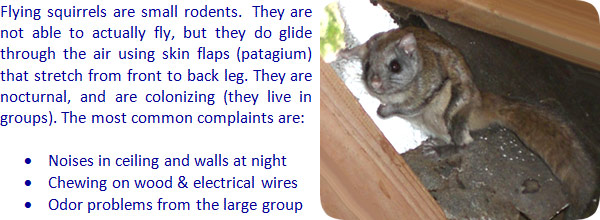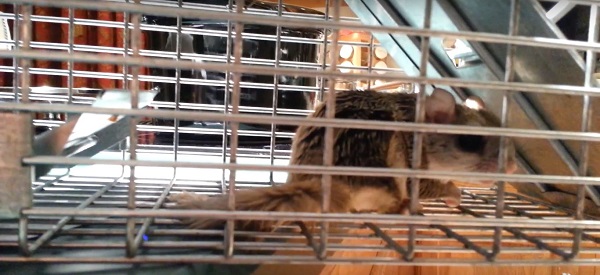 If you need help, click my Nationwide List of Flying Squirrel Removal Experts for a pro near you.
How to Kill a Flying Squirrel
If you need help, click my Nationwide List of Flying Squirrel Removal Experts for a pro near you.
How to Kill a Flying Squirrel
Flying squirrels are one the most unique furry friends that exists in North America. It is a rare sight to see one gliding through the blue sky with its body parachute. Just like other squirrels, the flying squirrel has a fluffy tail that it uses for balance, and especially comes in handy to stabilize while flying.
As animals of prey, their lives are quite perilous day to day. They are hunted by snakes, raccoons, owls, coyotes and house cats (and even humans!). While searching for food, they have to constantly check to see if someone’s on their tail. Occasionally, flying squirrels will escape into the living space of humans, especially attics. In such cases, it is easy for humans to assume they have to kill the critter to be rid of it. Sometimes this may be true, however, trapping and freeing a flying squirrel is an even better solution. Killing flying squirrels is also illegal. A rabid flying squirrel may be a good reason to kill the creature.
 Poison
Poison
Any type of rodent repellent spray will probably work to drive the squirrels out, as long as they do not escape into another room of your house. These sprays are very potent and smell awful, so they may not be the best choice. If the poison does kill the flying squirrel, there are high chances it will die inside a small crevice or hole in your wall, as it tries to escape but cannot. No matter how pesky the flying squirrel was in your attic, it will not compare to the stench left from a decaying animal in your wall.
Discarding
Picking up a dead flying squirrel with your bare hand can put you at risk of animal-borne diseases. Especially if the flying squirrel was rabid—do not use you’re bare hand. Instead, pick up the critter with rubber gloves or a plastic grocery sack.
Reinforcement
Make a call to your local humane society. Most local chapters will have a wildlife rescue department who can remove the flying squirrels safely and then release them into their natural habitat.
Forcing Them Out
Flying squirrels hate the smell of moth balls. Hang them in old socks around where they live and they should leave on their own. Same goes for strobe lights. The blinking is extremely uncomfortable and distressing.
Trapping
There are various types of critter traps, homemade and store bought, that can kill or catch flying squirrels. Flying squirrels are lighter in weight than regular squirrels, so make sure your traps will work with a lighter weight animal. Catch and release traps can be found at most any hardware store.
A deadly flying squirrel trap is a typical rat trap, found at your local hardware store. Screw it into a 2x4 and place in a dark area with bait. If you end up killing the squirrel, check as best you can to determine if it is a she and if she had been nursing (enlarged teats). If she had been, there is a family of baby flying squirrels that will continue to make a home in your attic.
Flying squirrels love the nutty taste of peanut butter and sunflower seeds. These are great options to set in your traps to lure them in.
Releasing
When you release a flying squirrel, make sure it is not right outside your house because it will want to come back in. Cover the trap with a tarp or blanket and simply take an afternoon drive until you reach a wilderness area. Make sure you wear hand protection—thick leather gloves, for instance—just in case the flying squirrel tries to bite you. If possible, release the flying squirrel over a body of water, like a stream, river or lake. Then smile as you watch the critters fly free and away from you.
Prevention
Keeping your house well sealed, especially when there known flying squirrels about, will keep them out of your house and in the wild. They can fit through small holes in the roof and walls and if you notice openings in your own house, board them up. Fill holes with moth balls steel wool—it is too difficult for them to bite through. Even contracting out professional workers can be worth the cost in the long run.
The most important thing to remember with flying squirrels is prevention goes a long way. It is much easier to prevent them from getting inside than dealing with them once they are inside.